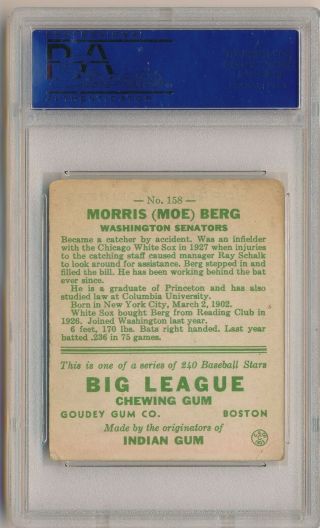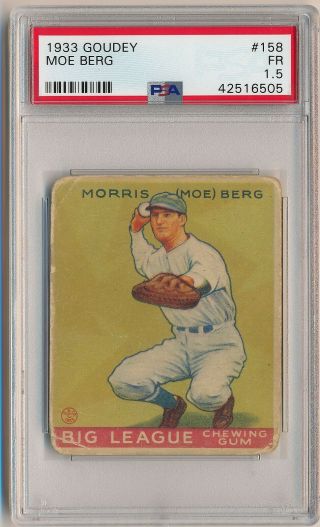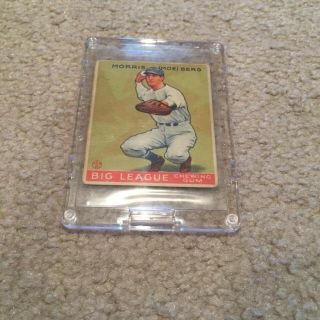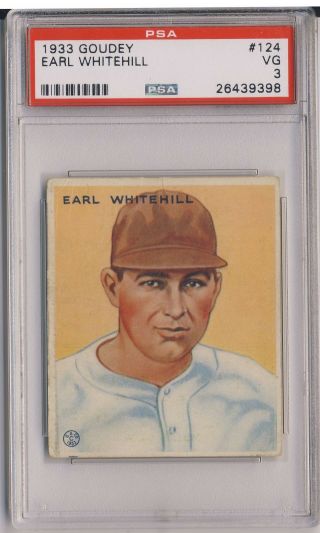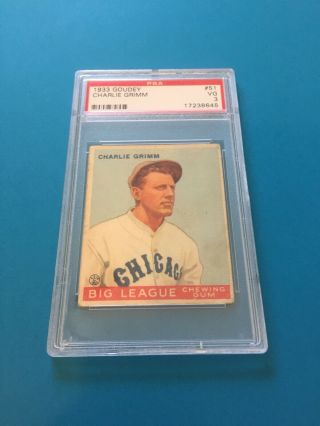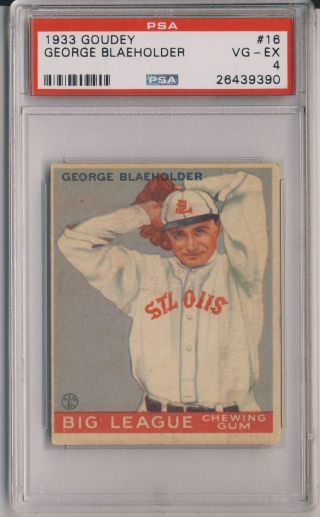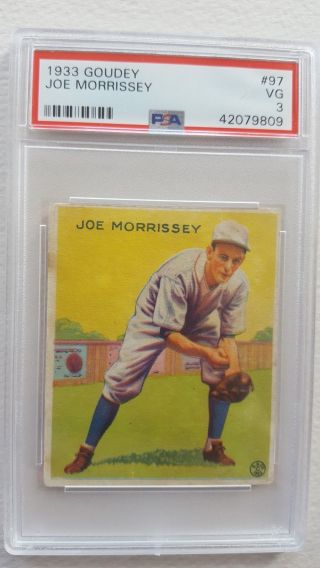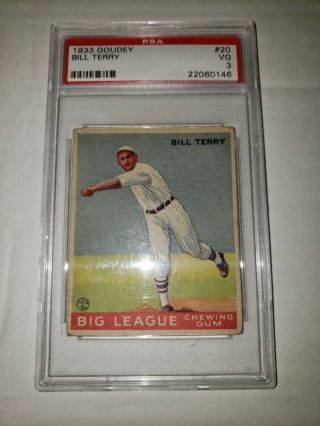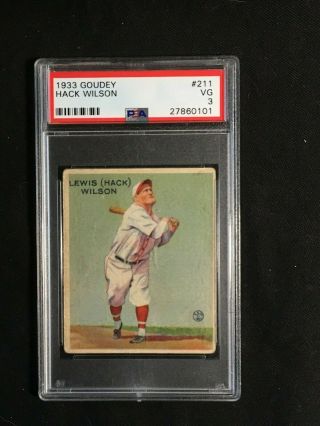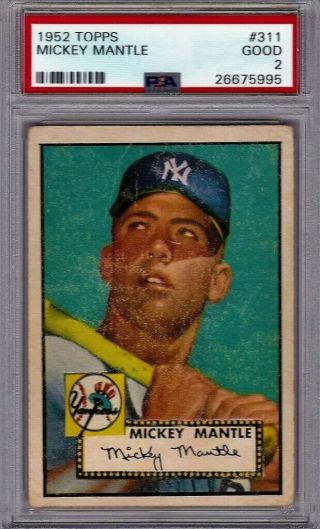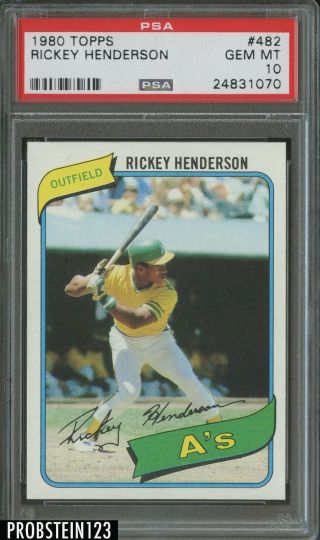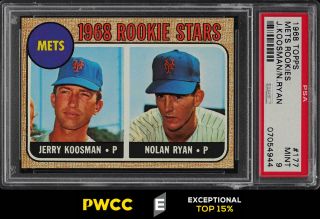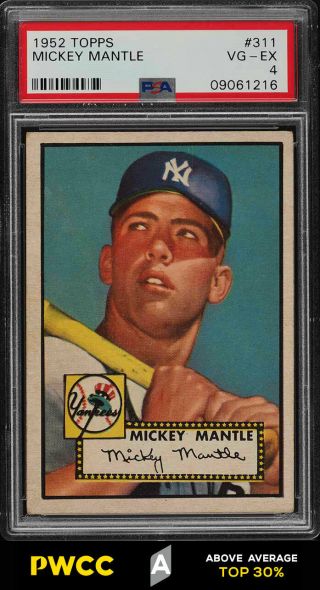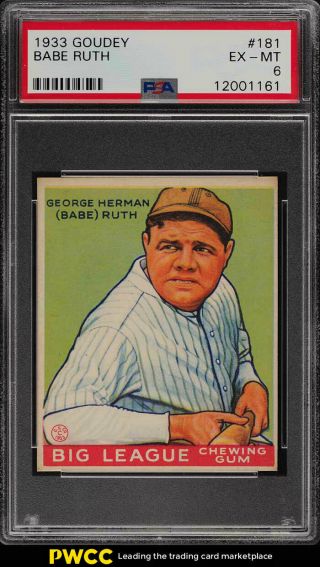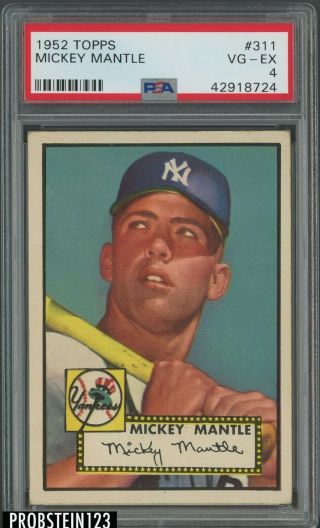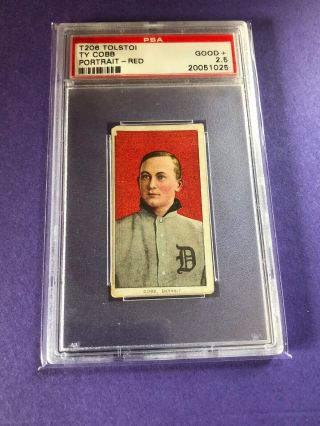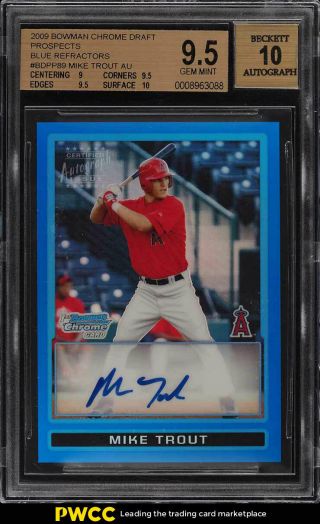MOE BERG 1933 Goudey Gum 158 PSA 3 VG US SPY WASHINGTON SENATORS Prewar Vintage
Item History & Price
Welcome to iconsportscards. I specialize in vintage sets and factory certified autograph and memorabilia cards from Hall of Fame greats. I pride myself on customer satisfaction, and providing a quality product at a reasonable price. Thank you for viewing my item, Chrisebaystores.com/iconsportscardsAll sportscard singles ship for one low rate, no matter how many items you buy! Item Description:
You are bidding on a Professionally Graded ...MOE BERG 1933 Goudey Gum #158 PSA 3 VG US SPY WASHINGTON SENATORS Prewar Vintage. Berg was an American catcher and coach in Major League Baseball who later served as a spy for the Office of Strategic Services during World War II. A very nice specimen from the 1933 Goudey Big League Chewing Gum card set, one of the most collectable sets of all time. Please scroll down for more about Goudey chewing gum baseball cards and the player.INTERNATIONAL BIDDERS WELCOMED!Shipping and Handling:
Shipment within the USA will be packaged securely in a flat rate priority box. International shipments will be packaged carefully and securely in a padded bubble mailer. Domestic and International shipments will be insured through Shipsaver, an Ebay approved insurance provider. I combine shipping at no extra charge for any additional items purchased. For more vintage Goudey cards, please check out my other items:ebaystores.com/iconsportscardsAbout the Set:
The 1933 Goudey (R319) set was produced by the Goudey Gum Company of Boston, MA and used to market tins/packs of chewing gum. The detailed artwork and vivid colors used to manufacture the cards are what make them a favorite among vintage collectors today. 1933 Goudey comprises of a 240 card set, each card measuring 2 3/8” x 2 7/8”. Key cards include Babe Ruth, who has four different cards in the set (53, 144, 149 & 181), Jimmy Foxx, Carl Hubell, Lefty Grove, Rogers Hornsby, Mel Ott, and many other legendary Hall of Famers. There is also a a very rare short-printed Nap Lajoie card (#106), which was not included in the regular print run of the set and is widely believed to have been intentionally left out in order to make it harder for collectors to finish the set.from Wikipedia:GoudeyFrom Wikipedia, the free encyclopedia Jimmy Foxx 1933 Goudey baseball card.The Goudey Gum Company was an American chewing gum company started in 1919. The company was founded by Enos Gordon Goudey (1863–1946) of Barrington Passage, Nova Scotia. Formerly an employee of Beemans, he opened a factory in Boston, Massachusetts in 1919 and later in Allston. It operated there from 1924 until it closed in 1962. Goudey sold the business in 1932 but he retained an interest as a consultant. On his retirement in 1933, William Wrigley Jr. dubbed him the "penny gum king of America". Today the Goudey name is mainly associated with its collectible baseball cards which were introduced in 1933. Goudey was the first American company to issue baseball cards with each stick of gum. (They had been available with cigarettes and certain lines of candy for many years.)[1][2]Goudey baseball cards Moe Berg Goudey cardMost of the unreleased cards, printing plates, and company archives were thrown away in the 1960s, although some were sold to collectors. Today, cards in good condition command a premium, especially those authenticated and graded by respected third-party graders. Hank Greenberg and Lou Gehrig are prominently featured in the Goudey cards of the 1930s, colorful cards with hand drawn portraits of the players. Other baseball hall of fame and interesting players depicted on Goudey gum cards from 1933 to 1941 include: Ty Cobb, Jimmie Foxx, Bill Dickey, Carl Hubbell, Lefty Grove, Dizzy Dean, Mickey Cochrane, Charlie Gehringer, Tony Lazzeri, Mel Ott, Joe Dimaggio, Hank Greenberg, "Ducky" Joe Medwick and Moe Berg.1933 set Nap Lajoie Goudey card, one of the rarest baseball cards.In 1933, Goudey produced a 240 card set, also called "Big League Chewing Gum". These cards, issued with bubble gum in each pack, were the first baseball gum cards. The 1933 Goudey set is considered one of the "Big Three" classic baseball card sets, along with the T206 and 1952 Topps sets.One of the rarest baseball cards from a mainstream set is card #106 from the 1933 Goudey set. It was not originally issued with the set, so collectors could not complete the set from packs. In 1934, Goudey issued card #106 for the 1933 set with retired player [Napoleon Lajoie]. Collectors that sent letters to the Goudey Gum Company complaining about the lack of a #106 card received it in the mail. The 1933 Goudey #106 Napoleon Lajoie is known as one of the "Big Three" baseball cards along with two cards from the T206 set depicting Honus Wagner and Eddie Plank.1934 setIn 1934, Goudey produced a 96 card set that was endorsed by two players, Lou Gehrig and Chuck Klein. The 1934 Goudey set is sometimes called the "Lou Gehrig" set. Interestingly, there are no Babe Ruth cards in the set. The Hank Greenberg rookie card is in this set.1938 setIn 1938, Goudey produced a 48 card set, also known as the "Heads-Up" set. The cards were numbered from 241 to 288, thus looking like Goudey was trying to extend the 1933 Goudey set. The first 24 cards in the set depicts pictures of players heads attached to a cartoonish body in baseball action. The next 24 cards in the set depicts the same players and the same poses. The difference is the next 24 cards include small cartoonish characters playing baseball along with captions. Joe Dimaggio, Jimmie Foxx, Hank Greenberg and Bob Feller are the big stars in this set.Canadian GoudeySimilar cards as the 1933 and 1934 Goudey sets were also released in Canada by the Goudey-owned World Wide Gum Co, of Granby, Quebec. They are sometimes known as Canadian Goudey sets. There were 94 and 96 cards in these sets, respectively. The 1933 World Wide Gum set was released with two different backs, one with both French and English, and the other with only English. There has not been definitive proof, but one theory is that the French-English backs were sold in Quebec and the English-only backs were sold in Ontario.List of Goudey baseball card setsYear of issuance, popular name and designation from The American Card Catalog:
1933 Goudey R319
1933 American R338
1933 World Wide Gum V353
1934 Goudey R320
1934 Goudey Premiums R390-1
1934 World Wide Gum V354
1935 Goudey 4-in-1 R321
1935 Goudey Premiums R390-2
1936 Goudey Wide Pens R314
1936 Goudey R322
1936 World Wide Gum V355
1938 Goudey "Heads-Up" R323
1939 Goudey Premiums R303
1939 World Wide Gum V351
1941 Goudey R324List of Goudey non-sport setsYear(s), name, quantity and dimensions.
1933 Boy Scouts (48) Size: 2⅛ × 3¼ in.
1933 Sea Raiders (48) Size: 2⅜ × 2⅞ in.
1933 World War Gum (96X 2⅞ in.
1933-40 Indian Gum (216) Size: 2⅜ × 2⅞ in.
1934 Big Thrill Booklets (24) Size: 2-5/16 × 2⅞ in.
1935 Majik Fold Pictures (9) Size: 5½ × 10¼ in.
1935 The Goudey Line R.R. 12 × 5 × 5 in.
1936 Auto License Plates (36) Size: 1½ × 3¼ in.
1936 History Of Aviation (10) Size: 5½" square
1937 Auto License Plates (69) Size: 1½ × 3¼ in.
1938 Auto License Plates (66) Size: 1½ × 3¼ in.
1938-39 Action Gum (96) Size: 2⅜ × 2⅞ inches
1939 Auto License Plates (30) Size: 1½ × 3¼ in.
1940 First Column Defenders (24) Size: 2½ × 3⅛ in.
1941 Sky Birds (24) Size: 2-5/16 × 2⅞ in.
1947-48 Indian Gum (96) Size: 2⅜ × 2⅞ in.
Jungle Gum (48) Size: 2⅜ × 2⅞ in.
Our Gang Gum Puzzles (25) Size: 3-11/16 × 5⅛ in.
Rainbow Radio Rascals (6) Size: 4⅜ × 5½ in.
Soldier Boys (24) Size: 2⅛ × 2⅞ in. Shipping and Handling:
Item will be packaged carefully and shipped securely. All graded cards will be secured with rigid cardboard inserts. All non-graded cards will be shipped securely in a penny sleeve and top-loader. All sportscard singles ship for one low rate, no matter how many items you buy! Combined shipping rates on lots may vary. Thanks! Thanks for viewing my item!Moe BergFrom Wikipedia, the free encyclopedia Moe BergCatcherBorn: March 2, 1902
New York City, New YorkDied: May 29, 1972 (aged 70)
Belleville, New JerseyBatted: RightThrew: RightMLB debutJune 27, 1923, for the Brooklyn RobinsLast MLB appearanceSeptember 1, 1939, for the Boston Red SoxMLB statisticsBatting average.243Hits441RBI206TeamsBrooklyn Robins (1923)Chicago White Sox (1926–1930)Cleveland Indians (1931)Washington Senators (1932–1934)Cleveland Indians (1934)Boston Red Sox (1935–1939)Morris "Moe" Berg (March 2, 1902 – May 29, 1972), was an American catcher and coach in Major League Baseball who later served as a spy for the Office of Strategic Services during World War II. Although he played 15 seasons in the major leagues, almost entirely for four American League teams, Berg was never more than an average player, usually used as a backup catcher, and was better known for being "the brainiest guy in baseball"[1] than for anything he accomplished in the game. Casey Stengel once described Berg as "the strangest man ever to play baseball".[2]A graduate of Princeton University and Columbia Law School, Berg spoke several languages and regularly read 10 newspapers a day. His reputation was fueled by his successful appearances as a contestant on the radio quiz show Information, Please, in which he answered questions about the derivation of words and names from Greek and Latin, historical events in Europe and the Far East, and ongoing international conferences.[3]As a spy working for the government of the United States, Berg traveled to Yugoslavia to gather intelligence on resistance groups the U.S. government was considering supporting. He was then sent on a mission to Italy, where he interviewed various physicists concerning the German nuclear program. After the war, Berg was occasionally employed by the OSS's successor, the Central Intelligence Agency, but, by the mid-1950s, was unemployed. He spent the last two decades of his life without work, living with various siblings.[4]Early lifeMoe Berg was Jewish and was the third and last child of Bernard Berg, a pharmacist, and Rose (Tashker), a homemaker, both Jewish, who lived in the Harlem section of New York City, New York, a few blocks from the Polo Grounds. When Berg was three and a half, he begged his mother to let him start school. In 1906, Bernard Berg bought a pharmacy in West Newark. In 1910 the Berg family moved again, to the Roseville section of Newark. Roseville offered Bernard Berg everything he wanted in a neighborhood—good schools, middle-class residents, and very few Jews.[5]Berg began playing baseball at the age of seven for the Roseville Methodist Episcopal Church baseball team under the less ethnic pseudonym Runt Wolfe. In 1918, at the age of 16, Berg graduated from Barringer High School. During his senior season, the Newark Star-Eagle selected a nine-man "dream team" for 1918 from the city's best prep and public high school baseball players, and Berg was named the team's third baseman. Barringer was the first in a series of institutions Berg joined in his life where his religion made him unusual. Most of the other students were East Side Italian Catholics or Protestants from Forest Hill, but there were not many Jews, just as Bernard wanted it.[6]After graduating from Barringer, Berg enrolled in New York University. He spent two semesters there and played baseball and basketball. In 1919 he transferred to Princeton University and never again mentioned that he had attended NYU for a year, presenting himself exclusively as a Princeton man.[7] Berg received a B.A., magna cum laude in modern languages. He had studied seven languages: Latin, Greek, French, Spanish, Italian, German and Sanskrit, studying with the philologist Harold H. Bender. His Jewish heritage and modest finances combined to keep him on the fringes of Princeton society, where he never quite fit in.[8]During his freshman year, Berg played first base on an undefeated team. Beginning in his sophomore year, he was the starting shortstop. He was not a great hitter and was a slow baserunner, but he had a strong, accurate throwing arm and sound baseball instincts. In his senior season, he was captain of the team and had a .337 batting average, batting .611 against Princeton's arch-rivals, Harvard and Yale. Berg and Crossan Cooper, Princeton's second baseman, communicated plays in Latin when there was a man on second base.[9]On June 26, 1923, Yale defeated Princeton 5–1 at Yankee Stadium to win the Big Three title. Berg had an outstanding day, getting two hits in four at bats (2–4) with a single and a double, and making several marvelous plays at shortstop. Both the New York Giants and the Brooklyn Robins (i.e., Dodgers) desired "Jewish blood" on their teams, to appeal to the large Jewish community in New York, and expressed interest in Berg. The Giants were especially interested, but they already had two future Hall of Famers at shortstop, Dave "Beauty" Bancroft and Travis Jackson. The Robins were a mediocre team, where Berg would have a better chance to play. On June 27, 1923, Berg signed his first big league contract for $5, 000 ($70, 000 today) with the Robins.[10]Major league careerEarly career (1923–1925)Berg's first game with the Robins came on June 27, 1923 against the Philadelphia Phillies at the Baker Bowl. Berg came in at the start of the seventh inning, replacing Ivy Olson at shortstop, when the Robins were winning 13–4. Berg handled five chances without an error and caught a line drive to start a game-ending double play. He got a hit in two at bats, singling up the middle against Clarence Mitchell, and scoring a run.[11][12] For the season, Berg batted .187 and made 21 errors in 47 games, his only National League experience.[13]After the season ended, Berg took his first trip abroad, sailing from New York to Paris. He settled in the Latin Quarter in an apartment that overlooked the Sorbonne, where he enrolled in 32 different classes.[14] In Paris he developed a habit he kept for the rest of his life: reading several newspapers daily.[15] Until Berg finished reading a paper, he considered it "alive" and refused to let anyone else touch it. When he was finished with it, he would consider the paper "dead" and anybody could read it.[2] In January 1924, instead of heading back to New York and getting himself into shape for the upcoming baseball season, Berg toured Italy and Switzerland.[15]During spring training at the Robins facility in Clearwater, Florida, manager Wilbert Robinson could see that Berg's hitting had not improved, and optioned him to the Minneapolis Millers of the American Association. Berg did not take the demotion well and threatened to quit baseball, but by mid-April he reported to the Millers. Berg did very well once he became the Millers' regular third baseman, hitting close to .330, but in July his average plummeted and he was back on the bench. On August 19, 1924 Berg was loaned to the Toledo Mud Hens, a poor team ravaged by injuries. Berg was immediately inserted into the lineup at shortstop when Rabbit Helgeth refused to pay a $10 ($140 today) fine for poor play and was suspended. Major league scout Mike González sent a telegram to the Dodgers evaluating Berg with the curt, but now famous, line, "Good field, no hit." Berg finished the season with a .264 average.[16]By April 1925, he was starting to show promise as a hitter with the Reading Keystones of the International League. Because of his .311 batting average and 124 runs batted in, the Chicago White Sox exercised their option they had with Reading, paying $6, 000 ($82, 000 today) for him, and moved Berg up to the big leagues the following year.[17]Career as a catcher (1926–1934)The 1926 season began with Berg informing the White Sox that he would skip spring training and the first two months of the season to complete his first year of law school at Columbia University, and Berg did not join the White Sox until May 28. Bill Hunnefield was signed by the White Sox to take Berg's place at shortstop, and was having a very good year, batting over .300. Berg played in only 41 games, batting .221.[18]Berg returned to Columbia after the season to continue working on his law degree. Despite White Sox owner Charles Comiskey offering him more money to come to spring training, Berg declined, and informed the White Sox that he would be reporting late for the 1927 season. Noel Dowling, a professor to whom Berg explained his situation, told Berg to take extra classes in the fall, and said that he would arrange with the dean a leave of absence from law school the following year, 1928.[19]Because he reported late, Berg spent the first three months of the season on the bench. In August, a series of injuries to catchers Ray Schalk, Harry McCurdy and Buck Crouse left the White Sox in need of somebody to play the position. Schalk, the White Sox player/manager, selected Berg, who did a fine job filling in. Schalk arranged for former Philadelphia Phillies catcher Frank Bruggy to meet the team at their next game, against the New York Yankees. Bruggy was so fat that pitcher Ted Lyons refused to pitch to him. When Schalk asked him whom he wanted to catch, Lyons selected Berg.[20]In Berg's debut as a starting catcher, he had to worry not only about catching Lyons' knuckleball, but also about facing the Yankees' Murderers' Row lineup, which included Babe Ruth, Lou Gehrig and Earle Combs. Lyons beat the Yankees 6–3, holding Ruth hitless. Berg made the defensive play of the game when he caught a poor throw from the outfield, spun and tagged out Joe Dugan at the plate. He caught eight more times during the final month and a half of the season.[21]To prepare for the 1928 season, Berg went up to a lumber camp in New York's Adirondack Mountains three weeks before reporting to the White Sox spring training facility in Shreveport, Louisiana. The hard labor did wonders for him, as he reported to spring training on March 2, 1928 in excellent shape. By the end of the season, Berg had established himself as the starting catcher.[22]At law school, Berg failed Evidence and did not graduate with the class of 1929, but he did pass the New York State bar exam. He repeated the evidence course the following year, and on February 26, 1930 received his LL.B.[23] On April 6, during an exhibition game against the Little Rock Travelers, his spikes caught in the soil as he tried to change directions and he tore a knee ligament.[24]He was back in the starting lineup on May 23, 1930, but his knee would not allow him to play every day. He played in only 20 games the whole season and finished with a .115 batting average. During the winter, he took a job with the respected Wall Street law firm Satterlee and Canfield (now Satterlee, Stephens, Burke & Burke). The Cleveland Indians picked him up on April 2, 1931 when Chicago put him on waivers, but he played in only 10 games with 13 at-bats and only 1 hit for the entire season.[25]"Yeah, I know, and he can't hit in any of them."[26]— Dave Harris, Senators' outfielder, when told that Berg spoke seven languagesThe Indians gave him his unconditional release in January 1932, but with catchers hard to come by, Clark Griffith, owner of the Washington Senators, invited him to spring training in Biloxi, Mississippi. He made the team, playing in 75 games while not committing an error. When starting catcher Roy Spencer went down with an injury, Berg stepped in, throwing out 35 baserunners while batting .236.[27]First trip to JapanRetired ballplayer Herb Hunter arranged for three players, Berg, Lefty O'Doul and Ted Lyons, to go to Japan to teach baseball seminars at Japanese universities during the winter of 1932. On October 22, 1932, the group of three players began their circuit of Meiji, Waseda, Rikkyo, Todai (Tokyo Imperial), Hosei, and Keio universities, the members of the Tokyo Big6 Baseball League. When the other Americans returned to the United States after their coaching assignments were over, Berg stayed behind to explore Japan. He went on to tour Manchuria, Shanghai, Peking, Indochina, Siam, India, Egypt and Berlin.[28]Despite his desire to go back to Japan, Berg reported to the Senators training camp on February 26, 1933 in Biloxi. He played in just 40 games during the season, and batted only .185. The Senators won the pennant, but lost to the Giants in the World Series. Cliff Bolton, the Senators' starting catcher in 1933, demanded more money in 1934. When the Senators refused to pay him more, he sat out and Berg got the starting job. On April 22, Berg made an error, his first fielding mistake since 1932—an American League record of 117 consecutive errorless games. On July 25, the Senators gave Berg his unconditional release. He soon returned to the big leagues, however, after Cleveland Indians catcher Glenn Myatt broke his ankle on August 1. Indians manager Walter Johnson, who had managed Berg in 1932, offered Berg the reserve catching job. Berg played sporadically until Frankie Pytlak, Cleveland's starting catcher, injured himself, and Berg became the starting catcher.[29]Second trip to JapanHerb Hunter arranged for a group of All-Stars, including Babe Ruth, Lou Gehrig, Earl Averill, Charlie Gehringer, Jimmie Foxx and Lefty Gomez, to tour Japan playing exhibitions against a Japanese all-star team. Despite the fact that Berg was a mediocre, third-string catcher, he was invited at the last minute to make the trip. Among the items Berg took with him to Japan were a 16-mm Bell & Howell movie camera and a letter from MovietoneNews, a New York City newsreel production company with which Berg had contracted to film the sights of his trip. When the team arrived in Japan, he gave a welcome speech in Japanese and also addressed the legislature.[30]On November 29, 1934, while the rest of the team was playing in Omiya, Berg went to Saint Luke's Hospital in Tsukiji, ostensibly to visit the daughter of American ambassador Joseph Grew. Instead, Berg sneaked onto the roof of the hospital, one of the tallest buildings in Tokyo, and filmed the city and harbor with his movie camera. He never did see the ambassador's daughter. Back at home, the Indians gave him his unconditional release. Berg continued on to the Philippines, Korea and Moscow.[31]Late career and coaching (1935–1941)After his return to America, Berg was picked up by the Boston Red Sox. In his five seasons with the Red Sox, Berg averaged fewer than 30 games a season.[32] On February 21, 1939, Berg made his first of three appearances on the radio quiz show, Information, Please. Berg put on a dazzling performance.[33] Of his appearance, baseball commissioner Kenesaw Mountain Landis told him, "Berg, in just thirty minutes you did more for baseball than I've done the entire time I've been commissioner".[34] On his third appearance, Clifton Fadiman, the moderator, started asking Berg too many personal questions. Berg did not answer any more questions and never appeared on the show again.[34] Regular show guest and sportswriter John Kieran later said that "Moe was the most scholarly professional athlete (I) ever knew."[35] After his playing career ended, Berg was a Red Sox coach in 1940 and 1941.[36]Post-baseball careerSpying for the U.S. GovernmentWith the attack on Pearl Harbor by the Japanese on December 7, 1941, the United States was thrust into World War II. To do his part for the war effort, Berg accepted a position with Nelson Rockefeller's Office of the Coordinator of Inter-American Affairs on January 5, 1942. Nine days later, his father, Bernard, died.[37] During the summer of 1942, Berg screened the footage he shot of Tokyo Bay for intelligence officers of the United States military. The film may have helped Lieutenant Colonel Jimmy Doolittle plan his famous Doolittle Raid.[38]From August 1942 to February 1943, Berg was on assignment in the Caribbean and South America. His job was to monitor the health and physical fitness of the American troops stationed there. Berg, along with several other OIAA agents, left in June 1943 because they thought South America posed little threat to the United States, and they wanted to be someplace where their talents would be put to better use.[39]On August 2, 1943, Berg accepted a position with the Office of Strategic Services Special Operations Branch (SO) for a salary of $3, 800 ($52, 600 today) a year. He was a paramilitary operations officer in the part of the OSS that is now called the CIA Special Activities Division. In September, he was assigned to the OSS Secret Intelligence branch (SI) and given a spot on the OSS SI Balkans desk. In this role, he parachuted into occupied Yugoslavia to evaluate the various resistance groups operating against the Nazis to determine which was the strongest. He talked to both Draža Mihailović and Tito and reviewed their forces, deciding that Tito had the stronger and better supported group. His evaluations were used to help determine the amount of support and aid to give each group.[40] In late 1943, Berg was assigned to Project Larson, an OSS operation set up by OSS Chief of Special Projects John Shaheen. The stated purpose of the project was to kidnap Italian rocket and missile specialists out of Italy and bring them to the U.S. However, there was another project hidden within Larson, called Project AZUSA, with the goal of interviewing Italian physicists to see what they knew about Werner Heisenberg and Carl Friedrich von Weizsäcker. It was similar in scope and mission to the Alsos project.[41] Berg turned down the Medal of Freedom during his lifetime; it was re-awarded after his death, with his sister accepting on his behalf.From May to mid-December 1944, Berg hopped around Europe interviewing physicists and trying to convince several to leave Europe and work in America. At the beginning of December, news about Heisenberg giving a lecture in Zürich reached the OSS. Berg was assigned to attend the lecture and determine "if anything Heisenberg said convinced him the Germans were close to a bomb." If Berg came to the conclusion that the Germans were close, he had orders to shoot Heisenberg; Berg determined that the Germans were not close.[42] During his time in Switzerland, Berg became close friends with physicist Paul Scherrer. Berg returned to the United States on April 25, 1945, and resigned from the Strategic Services Unit, the successor to the OSS, in August. He was awarded the Medal of Freedom on October 10, but he rejected the award on December 2. His sister accepted it on his behalf after his death.[43]After World War IIIn 1946, former Chicago White Sox teammate Ted Lyons was the new manager of the White Sox, and offered Berg a coaching position. Berg declined. Boston Red Sox owner Thomas Yawkey, who was much closer to Berg when he played for Red Sox, matched Lyons' offer, but Berg still turned them down. Berg did not apply for a teaching position, or join a law firm.In 1951, Berg begged the CIA to send him to Israel. "A Jew must do this", he wrote in his notebook. The CIA rejected Berg's request. Still, in 1952 Berg was hired by the CIA to use his old contacts from World War II to gather information about the Soviet atomic science. For the $10, 000 plus expenses that Berg received, the CIA received nothing in return. The CIA officer who spoke with Berg when he returned from Europe said that he was "flaky".[44] Berg continued to serve his assignment for the CIA until 1954, when his contract expired. The CIA chose not to renew it. Berg tried again to serve the CIA and the CIA again declined.For the next 20 years, Berg had no real job, living off friends and relatives who put up with him because of his charisma. When they would ask what he did for a living, he would reply by putting his finger to his lips, giving them the impression that he was still a spy.[45] A lifelong bachelor, he lived with his brother Samuel for 17 years. According to Samuel, he became moody and snappish after the war and did not seem to care for much in life besides his books. His brother finally grew fed up with the arrangement and asked Moe to leave and even had eviction papers drawn up.[2] After being evicted from his brother's home, Berg moved in with his sister Ethel in Belleville, New Jersey, where he remained for the rest of his life.[46]He received a handful of votes in Baseball Hall of Fame voting (four in 1958, and five in 1960). When he was criticized for "wasting" his intellectual talent on the sport he loved, Berg replied, "I'd rather be a ballplayer than a justice on the U.S. Supreme Court".[47]Berg received many requests to write his memoirs, but turned them down; he almost wrote them in 1960, but he quit after the co-writer assigned to him confused him with Moe Howard of the Three Stooges.[2]DeathMoe Berg died on May 29, 1972, at age 70, from injuries sustained in a fall at home. A nurse at the Belleville, New Jersey, hospital where he died recalled his final words as "How did the Mets do today?"[48] (They won.)[49] His remains were cremated and spread over Mount Scopus in Israel.[50]LegacyBerg was inducted into the National Jewish Sports Hall of Fame in 1996, [51] and the Baseball Reliquary's Shrine of the Eternals in 2000.[48] His is the only baseball card on display at the headquarters of the Central Intelligence Agency.[52]In April 2016, it was announced that American actor Paul Rudd will portray Berg in an upcoming biographical drama film called The Catcher Was a Spy, based on the book of the same name. The film will be directed by Ben Lewin and is likely to be released in 2017.[53]In 2017, Moe Berg will be the subject of a new film by documentarian Aviva Kempner.[54]
00048




